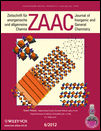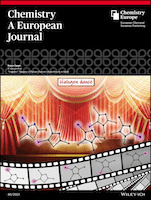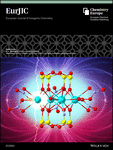
ZEITSCHRIFT FUR ANORGANISCHE UND ALLGEMEINE CHEMIE
Scope & Guideline
Unveiling the Secrets of Inorganic Substances
Introduction
Aims and Scopes
- Inorganic Synthesis and Characterization:
The journal highlights the synthesis of various inorganic materials, including coordination compounds, metal-organic frameworks (MOFs), and transition metal complexes, along with their detailed characterization through techniques such as X-ray crystallography, NMR, and spectroscopy. - Coordination Chemistry:
A significant focus is placed on coordination chemistry, exploring the structures, reactivity, and applications of metal complexes, particularly those involving transition metals and lanthanides. - Material Science and Applications:
The journal covers research on the development of inorganic materials for practical applications, such as catalysis, energy storage, and drug delivery systems, emphasizing their functional properties. - Theoretical and Computational Chemistry:
Papers that employ theoretical and computational methods to predict the properties and behaviors of inorganic compounds are prevalent, contributing to a deeper understanding of chemical phenomena. - Environmental and Biological Chemistry:
Research addressing the environmental impact of inorganic materials, as well as their biological interactions, is increasingly featured, reflecting a broader perspective on the implications of inorganic chemistry.
Trending and Emerging
- Metal-Organic Frameworks (MOFs):
There is a significant increase in the publication of studies related to the synthesis, characterization, and application of metal-organic frameworks, highlighting their potential in gas adsorption, catalysis, and drug delivery. - Sustainable and Green Chemistry:
Research focusing on environmentally friendly synthesis methods and the development of sustainable materials is on the rise, reflecting a global shift towards greener chemical processes. - Nanomaterials and Nanocomposites:
The emergence of studies involving nanostructured materials and their composites indicates a trend towards exploring their unique properties and applications in various fields, including electronics and biomedicine. - Electrocatalysis and Energy Storage:
There is an increasing emphasis on the development of new electrocatalysts and materials for energy storage applications, particularly in the context of renewable energy technologies. - Biological and Medicinal Inorganic Chemistry:
A growing interest in the biological implications of inorganic compounds, including their use in medicinal chemistry and as therapeutic agents, marks a significant trend in the journal's recent publications.
Declining or Waning
- Traditional Organometallic Chemistry:
There has been a noticeable decrease in papers focusing solely on traditional organometallic chemistry, with a shift towards more complex and functional systems that integrate organometallic compounds with other materials. - Basic Coordination Chemistry:
The publication of studies that are purely descriptive of coordination chemistry without novel insights or applications has declined, suggesting a move towards more application-oriented research. - Inorganic Reaction Mechanisms:
Research specifically detailing reaction mechanisms in inorganic chemistry appears less frequently, as the journal's emphasis shifts towards more practical applications and synthetic methodologies.
Similar Journals

CHINESE JOURNAL OF STRUCTURAL CHEMISTRY
Shaping the Future of Structural InsightsThe CHINESE JOURNAL OF STRUCTURAL CHEMISTRY, published by Elsevier, stands as a vital resource in the field of structural chemistry, notably contributing to the advancement of knowledge since its inception in 1996. With its ISSN 0254-5861 and E-ISSN 0254-5861, the journal has established a firm reputation, garnering a Q2 ranking in the 2023 Chemistry (miscellaneous) category, which highlights its influence in the academic community (rank #155/408, 62nd percentile in Scopus). This journal serves as an invaluable platform for researchers and professionals by disseminating high-quality research findings, theoretical studies, and applied methodologies that address both fundamental aspects and emerging trends in structural chemistry. With contributions from distinguished scholars, it aims to foster innovation and collaboration, while providing a space for novel discoveries in the field. Although it does not currently offer Open Access, its robust content continues to attract a diverse readership eager to engage with cutting-edge scientific developments.

JOURNAL OF CHEMICAL CRYSTALLOGRAPHY
Bridging disciplines through innovative research in crystallography.Welcome to the Journal of Chemical Crystallography, a prominent publication dedicated to the advancement of knowledge in the fields of chemical crystallography, general chemistry, and condensed matter physics. Published by Springer/Plenum Publishers, this journal provides a critical platform for researchers, professionals, and students to disseminate and access innovative research findings and methodologies from 1994 to 2024. With an ISSN of 1074-1542 and E-ISSN 1572-8854, the journal currently holds a Q4 quartile ranking in both Chemistry and Condensed Matter Physics, reflecting its broadening scope and niche significance within the scientific community. While it operates under a traditional access model, it endeavors to promote high-quality research that advances theoretical and practical aspects of crystallography, making it an essential resource for those involved in these dynamic disciplines. Join us as we explore the intricate world of chemical structures and their properties, bridging gaps between chemistry and physics.

TRANSITION METAL CHEMISTRY
Unraveling the Complexities of Metals and AlloysTransition Metal Chemistry is a distinguished journal published by Springer, focusing on the latest advancements in the field of inorganic chemistry, materials science, and metals and alloys. With an impressive publication history dating back to 1975, this journal serves as an essential platform for researchers and professionals seeking to explore the complexities and innovations in transition metal chemistry. Transition Metal Chemistry holds a Q4 ranking in Inorganic Chemistry and positions itself in Q3 within both Materials Chemistry and Metals and Alloys categories, highlighting its evolving influence in these domains. With a Scopus ranking of #41 in Inorganic Chemistry and #56 in Materials Science, it provides readers with valuable insights into research trends and discoveries. Although it does not offer open access, its rigorous peer-review process ensures that only the most impactful and validated studies are published. By bridging theoretical concepts and practical applications, Transition Metal Chemistry plays a pivotal role in advancing scientific knowledge, attracting a diverse audience of researchers, students, and industry professionals committed to unraveling the complexities of transition metals.

CHEMISTRY-A EUROPEAN JOURNAL
Leading the Charge in European Chemical ScienceCHEMISTRY-A EUROPEAN JOURNAL is a premier academic journal published by WILEY-V C H VERLAG GMBH, specializing in the diverse fields of chemistry and catalysis, with a distinguished focus on organic chemistry. Since its inception in 1995, the journal has established itself as an authoritative resource for researchers and professionals, currently classified in Q1 in Chemistry (miscellaneous) and Organic Chemistry, reflecting its high-quality contributions to the scientific community. With an impressive impact factor and robust Scopus rankings—#33 in Organic Chemistry and #26 in Catalysis—this journal serves as a vital platform for disseminating innovative research findings and critical advancements in chemical sciences. Although not an open-access journal, it provides valuable access options for institutions, ensuring wide reach and engagement within the scientific community. As it converges into 2024, CHEMISTRY-A EUROPEAN JOURNAL remains a key resource for anyone dedicated to advancing the frontiers of chemistry research.

Inorganics
Empowering Researchers in the World of InorganicsInorganics is a vibrant, peer-reviewed Open Access journal dedicated to advancing the field of inorganic chemistry, published by MDPI since 2013. Based in Switzerland, this journal aims to provide a dynamic platform for researchers, professionals, and students to share groundbreaking findings, fostering collaboration and innovation within the global scientific community. With an impressive Q2 ranking in the category of Inorganic Chemistry as of 2023, Inorganics stands out as a significant conduit for high-quality research that spans a wide range of topics from coordination compounds to metal-organic frameworks. Its commitment to accessibility ensures that cutting-edge research can be accessed, utilized, and built upon by a diverse audience, thereby amplifying its impact. Join the conversation in Inorganics and contribute to the ever-evolving landscape of inorganic chemical research.

EUROPEAN JOURNAL OF INORGANIC CHEMISTRY
Showcasing Excellence in Inorganic ResearchThe EUROPEAN JOURNAL OF INORGANIC CHEMISTRY, published by WILEY-V C H VERLAG GMBH, is a premier peer-reviewed journal dedicated to advancing the field of inorganic chemistry. With an ISSN of 1434-1948 and an E-ISSN of 1099-0682, this journal has established itself as a key platform for the dissemination of innovative research, reviews, and features since its inception. As of 2023, it holds a respectable Q2 quartile ranking in the domain of inorganic chemistry, reflecting its influence and contribution to the scientific community—ranking #33 out of 79 in Scopus’ assessment and placing the journal in the 58th percentile. The journal encompasses a wide range of topics within inorganic chemistry, making it a valuable resource for researchers, professionals, and students alike. Although the journal does not currently offer open access, it remains an essential outlet for high-quality, impactful studies in inorganic chemistry, showcasing significant advancements and fostering collaboration among scholars globally.

INDIAN JOURNAL OF CHEMISTRY
Connecting Researchers to the Latest in Organic, Inorganic, and Physical ChemistryINDIAN JOURNAL OF CHEMISTRY, published by the NATL INST SCIENCE COMMUNICATION & POLICY RESEARCH (NIScPR), stands as a vital platform for disseminating innovative research and advancements in the fields of organic, inorganic, and physical chemistry. With its inception in 1969, this journal has served the global community of chemists and researchers, contributing significantly to the advancement of chemical sciences in India and beyond. The journal maintains a strong commitment to open access, facilitating widespread dissemination of knowledge, allowing readers from diverse backgrounds to access cutting-edge research without barriers. Although coverage in Scopus has been temporarily discontinued, the journal continues to uphold rigorous scholarly standards, making it an authoritative source for academicians, professionals, and students alike. Readers can expect high-quality articles that reflect the latest developments and discoveries in chemistry, reinforcing the journal's reputation as an essential resource in the scientific community.

DALTON TRANSACTIONS
Catalyzing Collaboration in Chemical ResearchDALTON TRANSACTIONS, published by the esteemed Royal Society of Chemistry, is a premier journal in the field of Inorganic Chemistry, recognized for its significant contributions to advancing research and scholarship since its inception in 2002. With an impressive Impact Factor and ranked in the Q1 category, it holds a notable position at Rank #21 out of 79 within its Scopus category, highlighting its reputation for excellence and influence in the scientific community. This journal provides a platform for disseminating high-quality research, reviews, and communications related to all aspects of inorganic chemistry, fostering collaboration and innovation among researchers, professionals, and students alike. Although it does not offer open access, its robust selection process and commitment to scholarly integrity ensure that published works are of the highest standard. For those passionate about inorganic chemistry, DALTON TRANSACTIONS serves as an essential resource, fostering a deeper understanding of the field and its applications.

Inorganic and Nano-Metal Chemistry
Unveiling Breakthroughs in Nano-Metal Applications.Inorganic and Nano-Metal Chemistry is a premier journal published by Taylor & Francis Inc, focusing on innovative research and advancements in the fields of inorganic chemistry and nano-metal applications. With an increasing impact in the academic community, this journal has established itself within the Q3 category of both Inorganic Chemistry and Physical and Theoretical Chemistry as of 2023, reflecting its global recognition and influence. The journal is accessible as an Open Access publication, ensuring that research findings are freely available to a broad audience, promoting transparency and collaboration in scientific exploration. Based in the United Kingdom, Inorganic and Nano-Metal Chemistry aims to disseminate high-quality peer-reviewed articles that not only highlight fundamental studies but also push the boundaries of technological applications in areas such as catalysis, materials science, and nanotechnology. Researchers, professionals, and students will find this journal an invaluable resource for the latest developments and interdisciplinary insights in the ever-evolving landscape of inorganic and nano-metal chemistry.

RUSSIAN JOURNAL OF COORDINATION CHEMISTRY
Exploring the Nexus of Metal and MoleculeThe Russian Journal of Coordination Chemistry, published by Pleiades Publishing Inc, stands as a significant contribution to the field of coordination chemistry, focusing on the intricate relationships between metal ions and organic molecules. With an ISSN of 1070-3284 and an E-ISSN of 1608-3318, this journal has been curating high-quality research since its inception in 1996. Though it currently does not offer open access, the journal plays a crucial role in disseminating innovative findings, evidenced by its Q3 ranking in both Chemical Engineering and Chemistry categories as of 2023. With Scopus rankings placing it in the 40th percentile among general chemistry and chemical engineering journals, it demonstrates a commitment to advancing knowledge in these vital areas. The journal invites researchers, professionals, and students alike to engage with its comprehensive articles that explore both theoretical and practical aspects of coordination chemistry, supporting the development of new applications and techniques within the field.